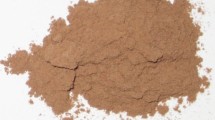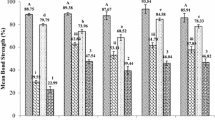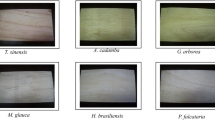Abstract
In the present study, the effect of adding the powder of waste PET (polyethylene terephthalate) bottles and borax pentahydrate in equal amounts to the urea-formaldehyde (UF) adhesive on the bonding characteristics and free formaldehyde content was studied. Experiments were conducted on three layered plywood of beech (Fagus orientalis) and poplar (Populus x eureamericana), which were produced using urea-formaldehyde adhesive to which powdered PET bottle and borax pentahydrate were added in certain amounts. Furthermore, the bending strength of the produced plywood was analyzed according to BS EN 320, the withdrawal shear strength according to BS EN 314-2, and the free formaldehyde content according to EN 717-2. The obtained results were then compared. It can be seen that the addition of powdered PET bottle and borax pentahydrate to the adhesive mixture used on the plywood statistically increased its bending strength and withdrawal shear strength but significantly reduced the free formaldehyde content.
Zusammenfassung
Untersucht wurde in dieser Studie der Einfluss der Zugabe jeweils gleicher Mengen an Pulver aus recyclierten PET- (Polyethylenterephtalat) Flaschen und Boraxpentahydrat zu Harnstoffformaldehydharz (UF) auf die Klebeigenschaften und den Gehalt an freiem Formaldehyd. Dazu wurden Versuche mit dreilagigem Buchen- (Fagus orientalis) und Pappelsperrholz (Populus x eureamericana) durchgeführt, die mit UF-Klebstoff hergestellt wurden, dem unterschiedliche Mengen an pulverisierten PET-Flaschen und Boraxpentahydrat beigemischt worden waren. Weiterhin wurden die Biegefestigkeit der hergestellten Platten gemäß EN 320, deren Scherfestigkeit gemäß EN 314-2 und deren Gehalt an freiem Formaldehyd gemäß EN 717-2 bestimmt und die Ergebnisse wurden verglichen. Es wurde gezeigt, dass durch Zugabe von pulverisierten PET-Flaschen und Boraxpentahydrat zum verwendeten Klebstoff die Biegefestigkeit und die Scherfestigkeit von Sperrholz signifikant zunahm und der Gehalt an freiem Formaldehyd signifikant zurückging.
Similar content being viewed by others
References
Baumann MGD, Lorenz LF, Batterman SA, Zhang GZ (2000) Aldehyde emissions from particleboard and medium density fiberboard products. Forest Prod J 50(9):75–82
Bodalal A, Zhang JS, Plett EG (2000) A method for measuring internal diffusion and equilibrium partition coefficients of volatile organic compounds for building materials. Build Environ 35:101–110
Bridaux V, Charrier B, Fauroux N, Charrier F, Gonzalez J (2001) Addition of boron based compound in the LVL glueline: Effect on the mechanical properties and the leaching of boron. Holzforschung 55:5
BS EN 310 (1993) Wood-based panels. Determination of modulus of elasticity in bending and of bending strength
BS EN 314-2 (1993) Plywood—Bonding quality Part 2: Requirements (R)
Colakoglu G, Colak S (2004) Volatile acetic acid and formaldehyde emission from plywood treated with boron compound. Build Environ 39:533–536
Colakoglu G, Demirkir C (2006) Characteristics of plywood panels produced with urea formaldehyde resin containing borax. Holz Roh-Werkst 64:250–251
Donmez A, Kalaycioglu H (2006) Some technological features of the oriented strand boards OSB produced with borax. III. In: International boron symposium, 2006, p 117
Ediz N, Ozday H (2001) Boron minerals and economy. J Inst Sci Technol Dumlupinar Univ 2, Kutahya
EN 717-2 (1994) Wood-based panels—Determination of formaldehyde release—Part 1: Formaldehyde emission by the gas analysis method
Nicolas M, Ramalho O, Maupetit F (2007) Reactions between ozone and building products: Impact on primary and secondary emissions. Atmos Environ 41:3129–3138
Ozalp M (2008) The investigation of borax pentahydrate influences with double components in varnish applications of wood materials. Wood Res 53(4):121–128
Sensogut C, Ozalp M, Yesil H (2009) The effect of borax pentahydrate addition to urea formaldehyde on the mechanical characteristics and free formaldehyde content of plywood. Int J Adhes Adhes 29(5):589–592
Singer BC, Coleman BK, Destaillats H, Hodgson AT (2006) Lunden MM, Weschler CJ, Nazaroff WW, Indoor secondary pollutants from cleaning product and air freshener use in the presence of ozone. Atmos Environ 40:6696–6710
Sundman MR, Larsen A, Vestin E, Weibull A (2007) Formaldehyde emission—Comparison of different standard methods. Atmos Environ 41:3193–3202
Uchiyama S, Matsushima E, Kitao N, Tokunaga H, Ando M, Otsubo Y (2007) Effect of natural compounds on reducing formaldehyde emission from plywood. Atmos Environ 41:8825–8830
Ulrich K (2007) Polyester bottle resins production, processing, properties and recycling. PET Planet Publisher GmbH, Heidelberg, Chap H
Wanner HU (1993) Sources of pollutants in indoor air. IARC Sci Publ 9:19–30
Zorlu I (1978) Wood workings construction knowledge. National education publishing house, Istanbul
Author information
Authors and Affiliations
Corresponding author
Rights and permissions
About this article
Cite this article
Ozalp, M. Study of the effect of adding the powder of waste PET bottles and borax pentahydrate to the urea formaldehyde adhesive applied on plywood. Eur. J. Wood Prod. 69, 369–374 (2011). https://doi.org/10.1007/s00107-010-0439-5
Received:
Published:
Issue Date:
DOI: https://doi.org/10.1007/s00107-010-0439-5




